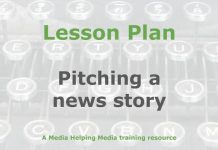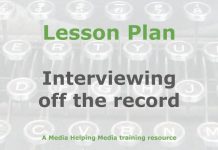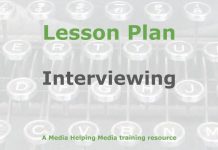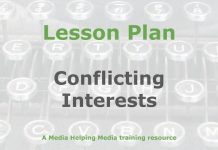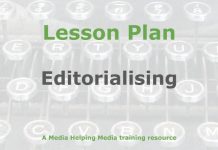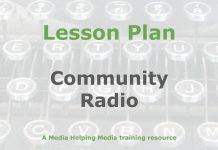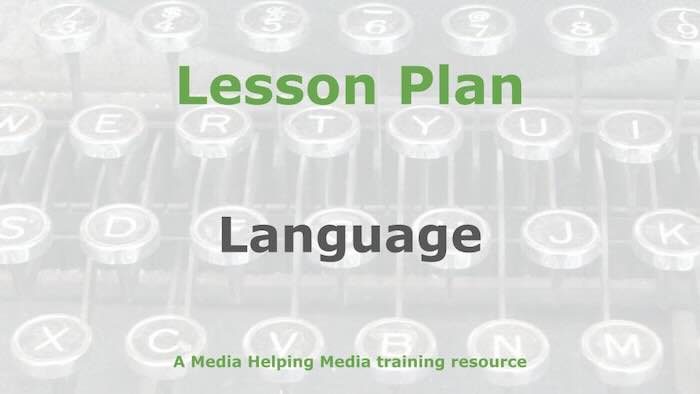 This lesson plan is designed to help students understand the importance of using the right language and style in their journalism.
This lesson plan is designed to help students understand the importance of using the right language and style in their journalism.
It’s based on the article ‘Language and style – the basics‘ which we recommend trainers read before adapting this lesson outline for your own purposes.
Learning objective
Students will analyse and apply effective language and style techniques in journalism to enhance clarity and engagement in news writing. They will evaluate sentence structure, word choice, and objectivity to ensure accurate and unbiased reporting.
- Student-facing objective: By the end of this lesson the student will be able to use clear and engaging language in my news writing, making sure my sentences are structured well and my reporting is fair and accurate.
- Standards: Students will learn about the best use of language and style in their news writing.
Learning activities
Warm-up
Begin with a brief discussion on the importance of clear communication in journalism. Ask students to think of a news story they’ve read or heard recently. Prompt them to consider:
- What made the story easy or difficult to understand?
- Were there any words or phrases that were confusing or unclear?
Encourage students to share their thoughts with a partner. After a few minutes, ask a few students to share their observations with the class. This will activate their prior knowledge about language clarity and prepare them for the lesson on effective language and style in journalism.
Direct instruction
- Conceptual understanding: Introduce the concept of language clarity in journalism. Explain the importance of using short, clear sentences to convey information effectively. Use real-world examples, such as comparing two versions of a news story: one with complex language and one with simplified language. Discuss how the simplified version enhances understanding.
- Procedural skills and fluency: Demonstrate how to construct sentences with a maximum of 20 words and no more than three ideas. Provide examples of sentences that exceed these limits and guide students in rewriting them for clarity. Emphasise the use of active voice and the elimination of unnecessary adjectives and adverbs.
- Application: Present a brief news story with complex language and ask students to rewrite it using the principles discussed. Encourage them to focus on sentence length, word choice, and active voice. Facilitate a class discussion on the changes made and how they improve the story’s clarity and engagement.
Guided practice
Think, Pair, Share: Guide students through a collaborative exercise to practice language clarity in journalism.
- Think: Present students with a complex news excerpt. Ask them to individually identify areas where language clarity can be improved, focusing on sentence length, word choice, and active voice.
- Pair: Have students pair up to discuss their observations. Encourage them to share their thoughts on how to simplify the language and enhance clarity.
- Share: Invite pairs to share their revised versions with the class. Facilitate a discussion on the effectiveness of the changes and how they contribute to clearer communication.
- Feedback: Provide constructive feedback on their revisions, highlighting successful strategies and suggesting further improvements.
- Reflection: Ask students to reflect on the exercise and write down one main takeaway about the importance of language clarity in journalism.
Independent practice
- Provide students with a news article containing complex language. Instruct them to independently rewrite the article, focusing on simplifying sentence structure, using active voice, and eliminating unnecessary words.
- Encourage students to apply the principles of language clarity and style discussed in class.
- Circulate to offer guidance and support as needed.
Assignment
Ask students these questions:
- How does using active voice improve clarity in news writing?
- Why is it important to limit sentence length in journalism?
- What’s one question you still have from today’s lesson?
Suggested answers:
- Suggested answer to Question 1: Active voice makes sentences clearer by showing who is doing the action, making it easier for readers to understand.
- Suggested answer to Question 2: Limiting sentence length helps prevent confusion and ensures that information is conveyed clearly and concisely.
Teacher resources
Differentiation guide
- Advanced learners: Encourage them to explore the nuances of language differences, such as UK vs. US English, and how these affect journalistic style. Challenge them to rewrite a news story in both styles, focusing on maintaining clarity and engagement.
- Striving learners: Provide sentence starters and templates to help them construct clear, concise sentences. Use guided examples to illustrate the transformation of complex sentences into simpler ones. Offer additional practice with identifying active vs. passive voice in sentences.
- Background reading: We recommend trainers read the article ‘Language and style – the basics‘ before adapting this lesson outline for your own purposes. It would also be good to share the link to the article with students.
Notable definitions
- Active voice: A sentence structure where the subject performs the action stated by the verb. It is preferred in journalism for clarity and directness.
- Objectivity: The practice of maintaining neutrality and fairness in reporting, avoiding bias or personal opinions.
- Sentence structure: The arrangement of words in a sentence to convey clear and concise meaning, often emphasising the use of short, simple sentences in journalism.
Required materials
- Whiteboard and markers
- Copies of a news article with complex language for each student
- Handouts with examples of active vs. passive voice
- Projector for displaying examples and student work
- Notebooks or paper for student reflections and exercises
Lesson summary
- Warm-up
- Direct instruction
- Guided practice
- Independent practice
- Assignment
The free teaching tools at the Khan Academy were used in the production of this lesson plan.
